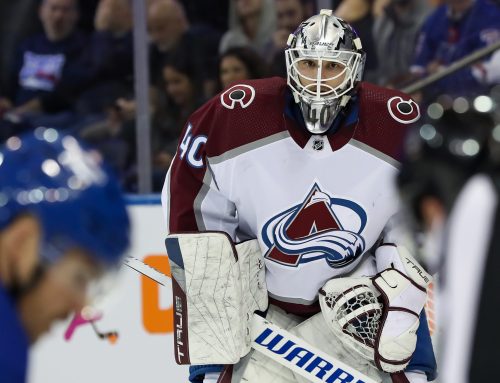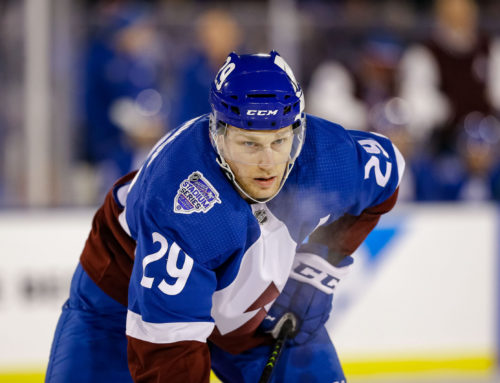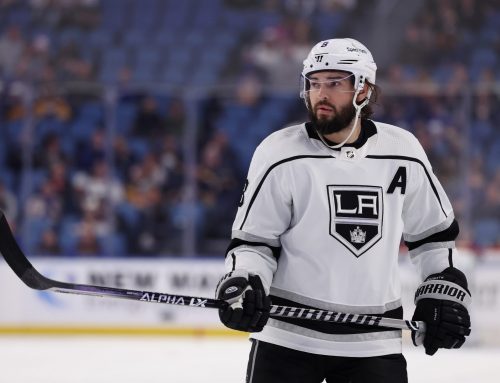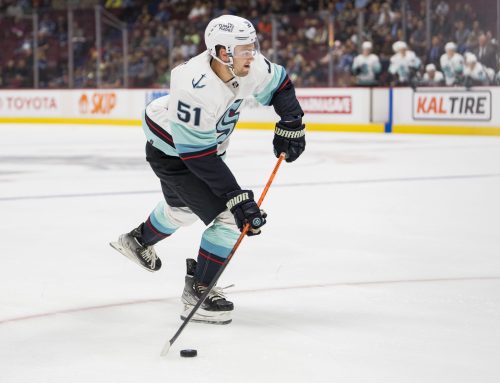West: Not Your Typical Second Liners
Doran Libin
2016-06-20

Libin takes a close look at Mathieu Perreault and Bo Horvat. What can you expect in the season ahead?
Second-liners in the NHL come in a variety of forms, the way each team uses its second line will dictate the value of each second-liner. Second-liners are often expected to produce between 40 to 60 points in the modern NHL but there is much more variance amongst the group. In the best possible scenario a second-liner gets usage like Evgeny Kuznetsov or David Krejci, where the first line goes best on best while the second line gets highly offensive-centric minutes. Conversely for teams on which the first line is set up to succeed the second line often has to pick up the slack defensively except in situations where the bottom six can thrive, or just survive, while being buried under heavy defensive zone starts. It is not always the line as a whole that gets more offensive usage sometimes it is just a player who finds his way on to the top power play unit or a single player gets more defensive responsibilities. This week features a couple examples of second-liners who are used in ways that impact their production significantly.
Perreault is in something of a hybrid of the situations described above, The Jets’ second line gets less offense-centric minutes than the top line but are helped by the bottom six playing very defensive minutes. Thus the second line still gets offense-centric minutes just not as good or as many. Before the Bryan Little injury and Andrew Ladd trade Perreault stood out on the Jets second line because he received top unit power play minutes unlike Mark Scheifele and Drew Stafford. That has been the case for both of the years in which Perreault has been on Jets. In both years he has had double digit power play points, accounting for at least 30% of his production in each year.
Perreault has had very similar numbers in both of his years with the Jets. He has averaged right around two shots per game in just over 16 minutes per game in each season. In fact he has even put up 41 points in each season, although last year he did it in nine extra games. Part of the reason for this dip in Perreault’s per game rate of production is that he scored half the goals he scored in previous years despite his shot rate being similar. The dip in his goal rate can be explained by his career worst shooting percentage of 6.8%, made worse by his even strength shooting of just over three percent. Such a precipitous drop in his shooting percentage is not explained by his quality of shot. As his shot rate was 91% of what it was the previous year while his expected goal rate was 86% of the previous year. Conversely his shooting percentage was only 48% of what it was the previous year.
Another way to look at drop in Perreault’s goal rate is as a function of how the team changed when after the Little injury. For Perreault the Little trade was significant because the Jets do not have a third center who can step up to fill the second line center position. After Little’s injury Perreault went from his most common linemates being Nikolaj Ehlers and Drew Stafford to them becoming Alex Burmistrov, Marko Dano and Drew Stafford. The main change is that Perreault went from playing with Scheifele to Burmistrov or Dano. While the lines got similar opportunities to those Perreault received before the Little injury they predominantly could not score despite having no trouble generating shots. This can be seen in the fact that Perreault was on for just over three goals per 60 minutes when playing with Scheifele to under two goals per 60 minutes without him. This is not a new pattern for the Jets and Perreault as there was a similar differential during the 2014/15 season. That is both worrisome, and surprising, as the Jets have dominated the run of play basically whenever Perreault is on the ice.
This goes to show how quickly a second liner’s fortunes can change as not many teams have three centers capable of playing top six minutes, or winger who makes that unnecessary. For Perreault this could be especially relevant this year as Jets ready for the potential arrival of Patrik Laine and Kyle Connor which could push an incumbent in the top six down to the bottom six. Perreault would otherwise seem well positioned for a big season, or at least a return to his previous rates of production, but the potential must be tempered a bit with all the moving pieces. Were Perreault to lose his power play time and remain on the second line he becomes a 30-point player or a 20-point player on the third line.
Horvat is on the other end of the spectrum from Perreault as last year he saw a lot of defensive zone starts, in fact he had the highest percentage of defensive zone starts on the Canucks. He also had the second lowest percentage of offensive zone starts amongst Canucks forwards who played more than 400 minutes. Horvat is a perfect example of a second line being expected to take on the primary shutdown and checking duties. Unsurprisingly Horvat was also expected to take on a significant role on the Canucks’ penalty kill, leaving little room for him to play a lot on the power play. As it is he was the most used forward on the penalty kill for the Canucks but received the fourth total minutes on the power play. Even at that Horvat received less than two minutes of power play time per game. At 17 minutes per game there is not a ton of room for Horvat to get more run on the power play without a major change to the way he is currently deployed.
With the Sedins still being the driving force offensively for the Canucks they naturally get the ice tilted in their favour with a high percentage of offensive zone starts. In order to be able to do that the Canucks require a line that can survive buried under extreme defensive zone starts. Horvat filled that role last year while still averaging half a point per game without possessing crazy high shooting percentages. Horvat serves as proof that being buried under high defensive zone starts does not have to be the death of a player’s ability to produce. Horvat had the third most points of players with more than 40% defensive zone starts. The only players with more points in similar usage are Ryan Kesler and Jean-Gabriel Pageau. Pageau is a bit of a different case as he played a different role when Kyle Turris was injured than he did the rest of the season. That puts Horvat amongst the very few forwards who can remain fantasy relevant while being used in this fashion.
Jim Benning, the Canucks’ GM, seems to think the Canucks have the makeup of a competitive team for this coming season. There is no other explanation for giving up a second round pick and Jared McCann for Erik Gudbranson. That also means that the probability that the Canucks make a one or two splashes in the free agent market. For a team that is largely bereft of offensive talent up front bringing in some offensive talent could better spread talent through the forward lines. That may not have much of an effect though for Horvat given his usage. It could mean more consistent linemates for Horvat, which would surely help as he did not have a single linemate last season for even 50% of his 1000 even strength minutes.
Greater consistency of linemate, or even better linemates, may help Horvat generate better shots. This past season saw his expected goal rate fall by a third of a goal despite his on-ice shot rate remaining constant. That drop in expected goal rate coincided with a shift in usage from Horvat’s rookie year to last year. Jumping from a relatively balanced distribution of zone starts to a more defensive role should account for much of the drop in shot quality for Horvat. It does mean, however, that Horvat’s jump in production was a reflection more of his increased ice time than anything else as can be seen by his production rate falling from 1.81 to 1.45 points per 60 minutes at even strength. Furthermore, Horvat overall rate of production even as his secondary assist rate went from 0.33 to 0.48 secondary assists per 60 minutes. That means Horvat saw a huge drop in his primary point rate which is concerning even given his tough usage.
The point of writing up two vastly different second liners was to illustrate how important it is to look beyond any nominal notion of which line a player plays on. Perreault and Horvat both play on the second line for their respective teams but Perreault had an off year and still managed to outscore Horvat despite playing fewer games. Usage is not the end all and be all for a player’s production but it certainly effects a player’s floor and ceiling as much as nominal notions of line.
2 Comments
Leave A Comment
You must be logged in to post a comment.





 MTL
MTL T.B
T.B COL
COL TOR
TOR CAR
CAR VAN
VAN VGK
VGK EDM
EDM NSH
NSH

I don’t see it noted here but it should be noted that Horvat was forced into the shutdown role because of the injury to Sutter. Sutter will shelter Horvat from the shutdown role this upcoming season – we’ll see what Horvat can do.
Sutter had very low defensive zone starts last year at 32%. He wasn’t used in a way that would pull defensive usage from Horvat. It would be silly to shelter Horvat because he was fairly successful in a buried role. Horvat is fine but he needs a significant change in usage or 40 points is his ceiling.
The point was never that usage is the sole defining factor in a player’s production. The point was rather that it is often more important than nominal notions such as ‘line’. All thing being equal in a one year league I’m taking Mathieu Perreault over Bo Horvat even though Horvat gets more minutes. Perreault had a horrible shooting year and still outpointed Horvat (41 to 40) because he gets offense-centric usage.